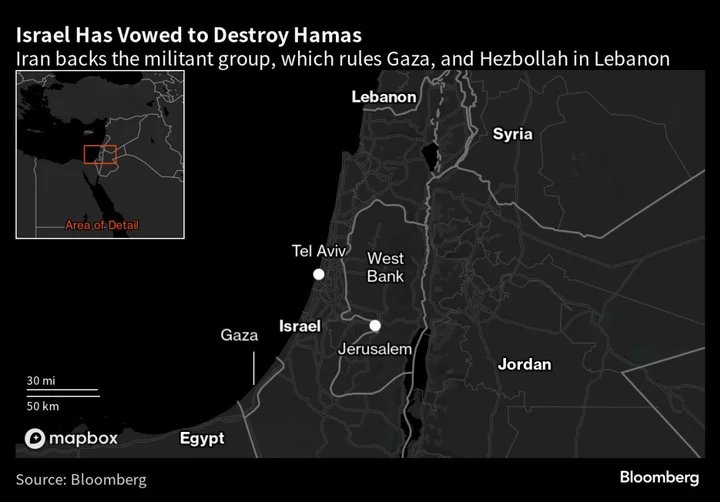Israel has sent troops and tanks into the northern Gaza Strip in what it calls the second and longer phase of its war against Hamas, a more cautious approach than what it vowed after the militant group’s Oct. 7 attack that killed 1,400 people.
Instead of a massive ground invasion, the military has started slowly, taking a day-by-day approach based on casualties, concerns of the conflict spreading to Hezbollah in the north and internal political pressures on Prime Minister Benjamin Netanyahu. The expectation is for the campaign to last anywhere from six weeks to six months, according to several officials.
The goal, according to officials, is distinct from previous conflicts with Gaza, when the plan was to leave Hamas damaged but still standing. Now, the government wants to destroy it as an organization and ensure Gaza is no longer a source of anti-Israeli violence, said the officials, who asked not to be identified discussing sensitive issues.
How realistic that is remains unclear, and the US and other allies are pressing Israel to be more specific about its aims, as well as sketch out a vision for what happens next.
More than a million Gazans are displaced in what has been called a humanitarian disaster, while international aid is only trickling in. According to the United Nations refugee agency there, its warehouses and distribution centers are being ransacked as civil order begins to unravel.
Read More: How the Israel-Hamas War Differs From Previous Conflicts
The decision to embark on a ground invasion does suggest a shift of focus away from negotiating over hostages, of which about 230 were taken by Hamas as part of the Oct. 7 incursion. It also indicates a belief that Iranian backed Hezbollah will content itself with brief exchanges rather than all-out combat, which would open up a battle on two fronts.
The sense had been that Hamas was trying to buy time, officials say, aiming to release just a couple of hostages per week while demanding an extensive ceasefire and prisoner exchange.
Read more: Israel Latest: Air Force Drops Leaflets Urging Hamas Surrender
Among the hostages are small children and the elderly. Many Israelis say getting them all back should be the only priority. But Netanyahu says the ground operation will advance a hostage release by pressuring Hamas leaders to stop dithering. Just prior to a press conference Saturday night, he visited families of those kidnapped.
Killing Hamas
Amos Yadlin, a former director of military intelligence, told reporters on a conference call that Israel’s goals include killing at least 10,000 Hamas militiamen out of a total of some 30,000.
Security services have set up a group whose task will be to target every Hamas leader involved in the Oct. 7 attack, officials say. Some have already been killed, according to the military. This echoes what Israel did after the 1972 Munich Summer Olympics when Palestinian gunmen took Israeli athletes hostage, leading to a number of their deaths. Israel sent assassins across the world to take out those who’d planned and carried out that attack.
Another goal that is being widely discussed is that Israel will not return the full Gaza Strip to whoever ends up ruling in place of Hamas. It plans to create a buffer zone to prevent any repeat attack, according to several officials.
“We don’t want to occupy and control two million Palestinians,” Yadlin said. “If we want kibbutzim and towns in the western Negev to come back, we need a buffer zone.”
Netanyahu is coming under growing internal pressure to resign because of the security failure ahead of Oct. 7 and his own unwillingness to accept personal responsibility. But so far there’s little evidence he will.
Overnight, he deleted a controversial social media post in which he said he hadn’t been warned by security chiefs about an impending Hamas attack and placed responsibility with them. He later apologized for the post.
He, along with many other Israeli leaders in recent years, had viewed Hamas, considered a terrorist organization by the US and the European Union, as a relatively primitive movement adjusting to its role as ruler of Gaza. Now it’s seen as a cunning and vicious militant group that will stop at nothing to kill Israelis and must not be allowed to exist.
His failure to have grasped that earlier has come under intense criticism.
Intense Bombardment
For the past two weeks, partly due to US and European pressure, Israel has limited itself to intensive bombardment from the air, sea and artillery, leading to the deaths of thousands of Palestinians, including some top Hamas military leaders.
Israeli officials say in the coming week, they will “increase dramatically” the amount of aid allowed into Gaza from Egypt, the army said on Sunday. “The amount will be much higher in the next few days,” Colonel Elad Goren told reporters on a conference call. He also said Israel has restored water supplies to southern Gaza, and the coastal strip has no shortage of food while hospitals have access to fuel to generate power.
Yet many in Gaza, where power and internet access are minimal, have given a very different account, saying life has turned hellish.
--With assistance from Henry Meyer.

